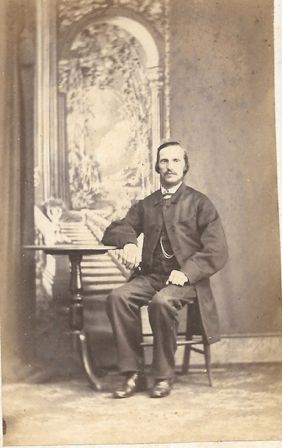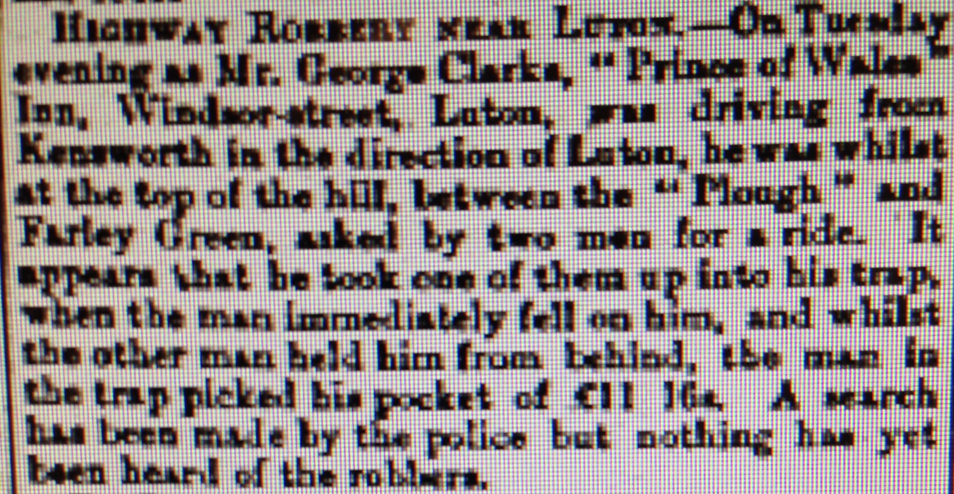INTERLUDE 1 – LUTON IN 1885
It would be useful to set out a brief outline of the town to set the scene.
Britain in 1885 had an empire upon which the sun never set and was fighting wars in the Sudan, Afghanistan and Burma. In government, the year began with Gladstone, a Liberal, as Prime Minister. He resigned over a budget defeat and Lord Salisbury, a Conservative, took over in June with a minority. There was a general election later in the year in which the newly formed constituency of Luton voted in Liberal M.P., Cyril Flower.
Luton was a medium sized market town with a population of 23,960 according to the 1881 census. It was a growing town as can be demonstrated by looking at comparable towns, Hitchin and Hertford. In 1801 Luton had a population of 3,095, Hitchin 3,161 and Hertford 3,360. By 1901 the populations were 36,404, 10,072 and 9,322 respectively. Luton was a wealthy town and attracted industry and workers from all over the country. Unlike surrounding towns, the land for expansion was made available by the various land owning families. The timing of the release of the land shaped the geographical directions in which Luton grew.
Rothesay Road cemetery was on the western edge of town. Cardiff Road was just being built. Land in Hibbert Street was sold in early 1885 and the Alms Houses number 1 to 24 were built and still stand today. Park Town went just past Bailey Street with Brache Farm at the southern tip of the town. There were fields between the Parish Church and Hart Hill and only Hart House stood on the hill. Round Green and Crawley Green were separate hamlets. Hartley Road was not built and High Town went only as far as Kingston Road towards Round Green. North Street had just been completed. There were just a few houses along New Bedford Road past Mill Street. Bury Farm was one of few buildings in what is now Bury Park. The Gas Works were just the other side of the railway line to Dunstable about where Sainsbury’s in Bury Park presently is. There were many meadows and open spaces around the town.
It was availability of land which enabled the hat industry to be concentrated mainly in Luton. If we consider that in 1832 St. Albans had 18 listed hat manufacturers with Luton only having 13 we can see the enormity of the shift. The move away from St. Albans was accelerated by the coming of the railway. Hat manufacturers in St. Albans were a long way from the station whereas the opposite was true in Luton (which meant that the town never showed a nice face towards the railway).
“Cartes de visite” were popular and exchanged by familes and friends. There were many photographers in the town and the two Cartes de Visite above, are by Luton photographers. The identities of the people are not known but it gives us an idea of the attire worn at this time.
There were ups and downs in the hat industry at various times – there was a riot in 1854 at the time of the Crimean war when prices were depressed. But in the main, when there was unrest elsewhere, Luton and the surrounding areas were relatively peaceful. Straw Plaiting could be done by women and children at home and drew in a good income. Sewing hats in Luton was an even better paid job and women flocked to the town to work. The Luton Poor Law Registration District for 1881 showed that 1,623 men and 7,408 women worked in the “dress” industry. This was made up of;
Hatter, Hat Manufacturer – 91 men and 441 women
Straw Hat, Bonnet and Plait manufacturer – 1,508 men and 5.915 women.
Milliner, dress and staymakers – 24 men and 1,052 women.
The ratio of women to men was variously estimated by the inhabitants as between 4 to one, and up to 11 to one. This was not lost on the surrounding towns and villages and there were many jibes at the town. Working women were resented by many in Victorian England which fuelled some of the prejudice against the town. Due to their sewing skills the women of Luton were some of the best dressed in the kingdom, which did not go down well with our neighbours. However, the bitterest pill that others could not swallow was that women could earn more than most men in the town with their sewing skills. This was more than some of Luton’s jealous neighbours could bear and the odious legends began – the men of Luton spend all day drinking in the pub while the women work. The two Luton Newspapers carried Hertfordshire news and the Hertfordshire papers did likewise for Bedfordshire and they took every opportunity to take a swipe at Luton. There was a direct rivalry between Luton and St. Albans at this time, probably attributable to the hat industry.
The hat industry did give women a sense of independence. If a husband died, became ill or unemployed then a woman would generally be able to cope. A bonus was that a wife could get rid of an unloved husband and live comfortably. It also worked the other way though. Men had a wide choice of women due to the uneven ratio, and could leave their wife knowing she would be fine financially if he left her.

The wealth of the town was evident from its buildings. There were many fine residences around the town. The Old Town Hall had been built in 1847 at a cost of £2,000. The public library was opposite. The Corn Exchange on Market Hill was just 17 years old. Corn was exchanged there and there was also a vegetable and provision market. The Court House was in Stuart Street and the fire brigade in Church Street. The cottage hospital, “The Bute Hospital”, was on Dunstable Road adjacent to the Workhouse and near to the football meadows in Dallow Lane. There were three colleges, Norton House, Grosvenor House and St. John’s, where boys were sent from all over the country and Empire to prepare them for university and public office. There were also a college for young ladies at Park Square. Education also helped adults obtain better paid jobs and evening classes were available in many subjects such as book keeping for the Hat manufacturers.
There were two markets. On Monday’s cattle, corn and straw plait was sold, the latter at the Plait Hall in Waller Street. The Saturday market was for the usual household provisions. There were three cattle fairs held in April, September and October.

As we have seen the majority of the population was employed in the hat industry including straw plait dealing, dyeing and bleaching. Agriculture also employed a great many. The other major employers were Hayward Tyler, Howard’s iron and brass foundry and Brown and Green’s iron foundry and there were two breweries, J.W. Green’s and Sworders. The average wage of an agricultural labourer was 16 shillings a week, for a policeman £1 10 shillings, for a skilled textile worker £1 13 shillings and for a teacher £2 6 shillings. There were 12 pennies to a shilling and 20 shillings to a pound. Two shillings and 6 pence would be shown as 2/6.
A suit for a child consisting of a jacket and knee length shorts cost between 2/11 and 8/11. Sailor suits were popular for the children of the wealthy. Ladies clothing was at the peak of awkwardness with ankle length dresses and bustle’s. Ladies shoes cost from 4/6 upwards. A mans Frock coat (knee length) cost 19/11. Straw Boaters started from 1/9. A football jersey started at 3/6 up to 3/11, breeches 10/6, hose (long socks) 1/11 up to 2/6 and caps from 9d up to 1s. Snake belts were used when braces were not appropriate such as on the football pitch. Moustaches were very popular for men. And everyone wore a hat.
Rent for a working class family of four would be about 11s a week. Vegetables for a week would be 3s, butter 1s, joint of meat (to last three days) 2/7. Dark cold winters meant more was spent on oil for lamps and coal for heating. This might result in paying less rent in the winter and paying it back over the warmer, lighter summer months. For those who were destitute, the Workhouse awaited.
The health of the town was reported in the local newspapers most months. In one month, of 65 deaths in the town, 36 were of children under the age of 15. The children died of measles, whooping cough, diarrhoea, diphtheria, and “wasting infantile”. Other major killers of the time for all were bronchitis, phthisis, cancer and industrial accidents. People died regularly in fires and there were many accidents involving horse drawn transport.
Perhaps because of the continuous wars in the Victorian era, people turned to religion and it played a huge role in the community. Luton had the 4th highest Sunday school attendances in the country. The church not only offered prayer but schooling, bazaars, sports, parties, outings, plays and concerts. The three Church of England parishes were St. Mary’s, Christ Church at the top of Upper George Street (now offices) and St. Matthews. The non conformists were well represented – Park Street Baptist Church could seat 1,000 people, the Ebenezer Chapel in Hastings Street over 500. The Wesleyan Chapel in Union Street could seat a massive 1,863 people, their Waller Street Chapel 1,000 and North Street 270. The Congregational Chapel in King Street could seat 1,150.
The Church activities helped reduce crime as did the Temperance Movement who were successful in turning many away from alcohol. The Coffee Tavern Movement provided people with an alternative to a Public House. Activities such as football, cricket, cycling and skating were popular. There was a skating rink behind the Town Hall and the swimming baths were also used. There appear to have been more than one cycle club in the town and when the weather was fine long trips were made. The safety bicycle was just coming into use at this time ousting the Penny Farthing as the preferred mode of transport.
There was theatre, concerts, magic lantern shows, the circus and lectures were popular, especially those on foreign travel. The local newspapers carried adverts for travel to America and the Empire. A new life in one of the younger countries appealed to many.
There was crime in and around the town – fights, highway robbery, burglary and so on were evident. The problem of youth crime was tackled by giving the young something to do. Christ Church opened a young men’s institute in November 1879. It had two rooms in Stuart Place for the Christ Church parish. It had chess, draughts and other games in one room and papers and periodicals in the other. “The rooms are made comfortable and it is hoped that many young men of the parish will appreciate its advantages”. Christ Church Institute would form a football and a cricket team both of which would play in the town for many years.
Thanks to
Strawopolis, Luton transformed 1840 – 1876 by Stephen Bunker.
The Luton Story by James Dyer, Frank Stygall and John Dony
The History of Luton by William Austin
The Luton Reporter and Beds and Herts Advertiser
The Luton Times and Bedfordshire Advertiser
The Luton News





